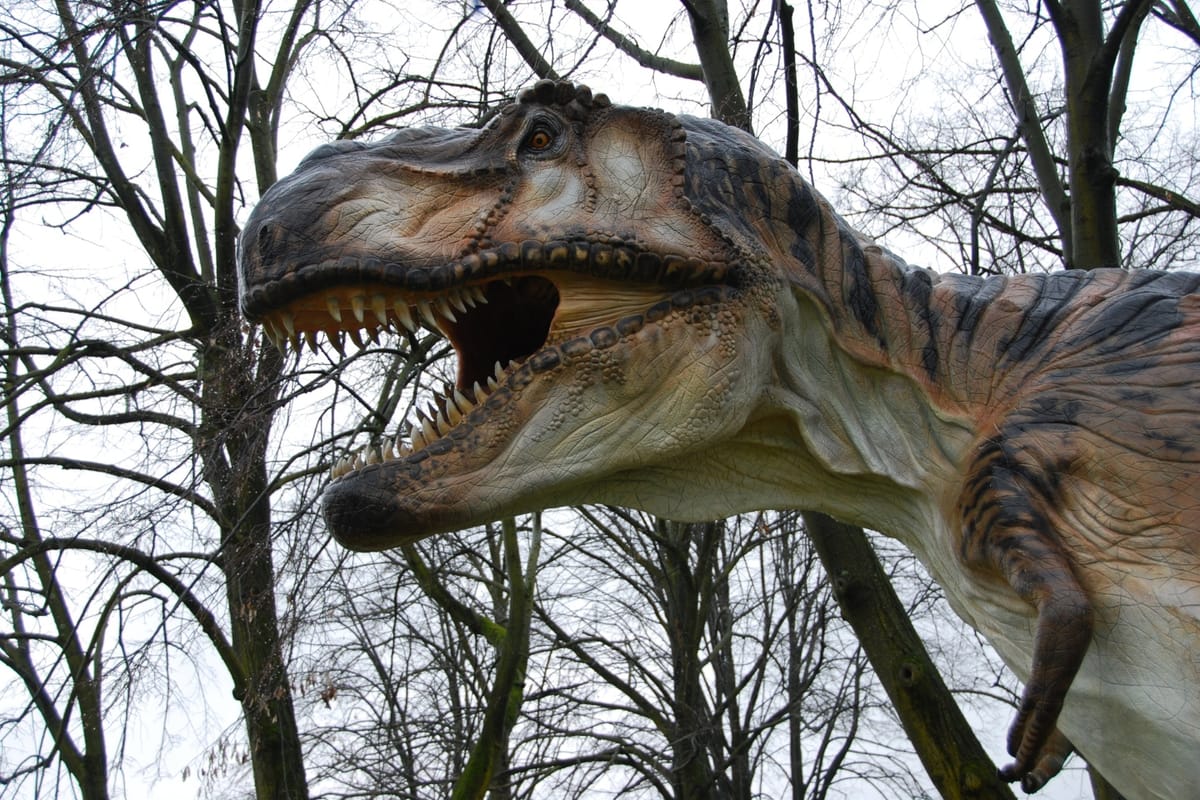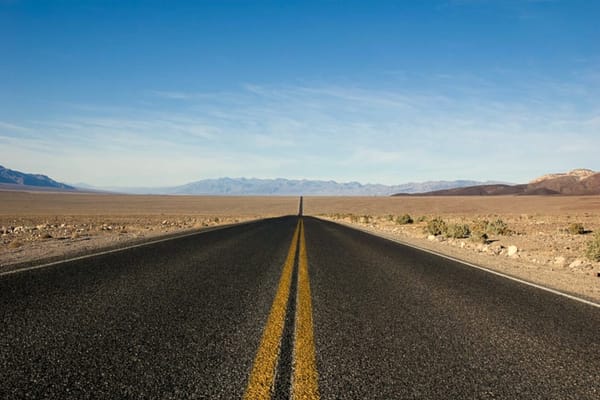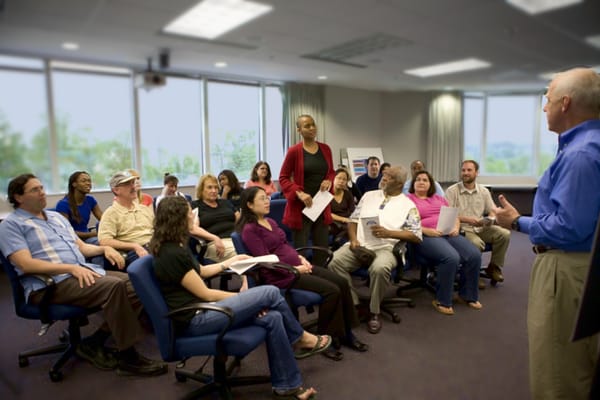Chaos Theory

Jurassic Park introduced most of us to chaos theory. You may think that disaster could’ve been prevented if not for Dennis Nedry, the T-Rex, or XYZ, but this misses the point. Chaos theory warns us to anticipate the unpredictable when many factors interact. John Hammond, however, committed to the idea of the park, then wanted to fix this or that after a death. But park users, human and dinosaur alike, won’t conform to expectations.
Transcript
Jonathan: The Yellow Light, Episode Two: Chaos Theory.
Recently in the news, there was this talk of bringing back a form of wolf that had gone extinct, the dire wolf.
Well, it turned out to be a whole lot of nothing. As with many stories, the mainstream media tends to inflate advances in science. I’ve seen them my whole life, with life on Mars or life on this other planet, bio-signatures, blah, blah, blah—whatever.
The point of the story is, eh, well, some people brought back some DNA. They haven’t really made the dire wolf go not extinct. They’ve just created some gray wolf–dire wolf hybrids. But this reminds me of a story, a story that was in a book and later got adapted to a movie, Jurassic Park.
In Jurassic Park, the ethics of cloning extinct animals came up, of course. We all know Jeff Goldblum’s character and his talk of Chaos Theory and “life finds a way”—and it’s been the source of many memes. But we should really go back and think about the questions in that movie and what it means to approach these problems, not in terms of “Oh, does nature give a species a chance to exist” and “We have to let nature take its course—they went extinct, blah, blah, blah.”
No. It’s really more, what I find interesting is the disaster that unfolds on the island. The T-Rex gets out of its enclosure and goes on a killing spree.
Basically, it’s like a horror movie—kind of an action movie, kind of a horror movie—and that’s the theme of the story.
The interesting thing was not that the Dennis Nedry character, the one who automated and computerized so many of the systems, the problem wasn’t that he computerized everything, that everybody was too reliant on one person, that they didn’t deal with enough problems and surprises as they came up. One of the characters, it was actually Laura Dern’s character in the movie adaptation, has that talk with the idealistic John Hammond. He says, you know, I’ve learned, like, we rely too much on automation and one person who disappeared, Dennis Nedry.
When we get control again, and then Laura Dern interrupts him and says, “You never had control—That’s the illusion.” And I think that’s an important thing.
This was explored more in the book actually, is that the way systems can fail is very unpredictable. Sometimes Chaos Theory gets reduced to a few memes or images or the expression of a butterfly flaps its wings in New York City and it causes a storm in Beijing—or however that goes. It doesn’t matter.
My point is that the systems in Jurassic Park failed in ways that nobody could predict. And taking the approach of solving problems as they came up and looking at them, okay, now we know how to do this. Now we know not to do that.
Now we know to do this. You know, you can see it. The best thing, one of the smartest people was actually the Muldoon character, the game warden character.
He says about the raptors, they just didn’t exist. We never have them in the park. They’re just too dangerous, too smart, too blah, blah, blah.
It set aside the fact that in real life, velociraptors were not much bigger than chickens. They would be a nuisance, but they aren’t going to hunt you down. Whatever, it’s a little bit of artistic liberty, we’ll say.
But the interesting point is that they were the deadliest thing. The T-Rex was just a big dumb animal that wants to eat sometimes. Whereas the raptors would hunt, they were more evil, almost more like a horror villain.
You think about them stalking the two kids when they were in the kitchen and that’s it. It felt very much like that, like they were villains. And they never were, but it felt as if they were.
The Muldoon character insisted that this danger shouldn’t exist. And we know that from studying industrial safety, production safety, what have you. The safest thing to do is to remove the danger.
It’s not to get you a better and more protective glove. It’s to have the on button for the trash compactor be ten feet away from the entrance, from the opening of the trash compactor. So that way it’s impossible for you to have your hand in the machine while the machine’s running, because you have to put the garbage in the trash compactor, then walk over to the on button and then press the on button.
It’s basically impossible for you to accidentally capture your hand in there. The best thing you could do would be to not even have a trash compactor. If you go to a convenience shop, there’s no trash compactor where the customers go.
So there’s no danger of a customer losing a hand at a convenience store. It’s just impossible to happen. That’s what Muldoon was saying with the raptors in a way.
They were so dangerous. They just shouldn’t exist, period. Not they should exist with more safety guards.
They just shouldn’t exist at all because things can go wrong. And Spielberg, as a great director, establishes that early on with his character where he oversees an accident. And that’s what it was.
It was an accident. Nobody intended for it to happen, but it was actually, you know, these things happen. It was a very emotional moment for him when one of the workers he supervised died—died from a raptor attack because things just go wrong. You know, you’re moving the raptor from one cage to another. Something nobody anticipated was that the raptor would wait at the back of the cage and then make a running start and then slam the door at the very moment that the cage is starting to open to reconnect or couple with the other cage or place we’re putting it.
It doesn’t matter what it was exactly. The point was that they hadn’t predicted, oh, the raptor might try to suddenly move at the weakest, most critical moment, which is right before we had the cage fully coupled with the next one and we opened the door. That’s the moment when it chooses to strike.
It didn’t matter if that was because the raptor was very smart or it was just blind luck. The fact is these kinds of things can happen and somebody lost his life. It didn’t need to happen.
The character also had a few other things that he said when the ride is going on and then the characters get out of the moving trucks on the track. They get out and they want to look at some stuff. And John was like, “Oh, no,” and Muldoon is saying, “I told you. You should have put locking mechanisms in the vehicles.” Muldoon was thinking not just in terms of safety for safety’s sake. And I’ll be like, oh, all this is all too dangerous.
He didn’t say that they should get rid of the T-Rex. It was really the raptor that he said to get rid of because they were just too unpredictable. For the sake of the story, they were made a lot bigger than they are in real life.
Not as big as the T-Rex, but much bigger than they were in real life. He also talked about the mechanisms on the doors because he was thinking with a preventive mindset. And we really need to have more of that in society.
A lot of times we go whole hog, we go all in on something and then we figure out the problems later. And I’m not saying we shouldn’t take any new steps or adopt anything, but we shouldn’t just deal with problems as they come up. We should anticipate possible problems and design ways for the problems to not kill anybody.
We need to do that from the outset. A lot of safety, we talk about Vision Zero, this and that. It’s always reactive.
It’s always, oh, well, we found out that this intersection is bad. So maybe at this traffic intersection, we can do XYZ. Or, hmm, people aren’t driving the way we wanted them to. Let’s try this.
No, you should have designed from the get-go. Before you put in the traffic intersection, before you do any construction, before you rebuild any intersection. And remember, the way car roadways are built and made, the heaviness of cars, you have to rebuild these every 15 years.
You don’t just pave them over. You have to rip up everything and redo them. That’s a chance to do it a different way.
And before you redo it the way it was, people who oversee safety should be in there beforehand, not after the fact and then have recommendations. By then, it’s too late. Somebody’s died.
That’s when people invoke the safety. No, the safety mindset should be there from the get-go. If you wanted people to stay in the cars on the Jurassic Park ride, they need to have locking mechanisms so that people can just leave.
If you want people to not die on your roads, you need to not design intersections in a way that will induce people to drive too fast. And they will. We know that.
We have enough decades of research around the world. We have the research. It doesn’t matter how we got it.
We have it now. Let’s put it to use. Let’s not rebuild dangerous intersections.
And if we find that we did build one, we need to think about how to fundamentally change it or redesign it and not be the mindset like, we need some more flashing lights. That’s not going to make a difference. If people are driving too fast and plowing and killing people, it’s not because they choose to.
So saying something is an accident is really irrelevant. And making people more, besides making them more visible, if you daylight an intersection and you make people more visible, that can help. You remove visual obstacles.
You don’t let people park on the street too close to an intersection because it might hide people in the crosswalk. Getting rid of those visual obstacles is good. But lighting up an intersection by having a flashing sign, not on the person, but off to the side, so you have to divert your attention—you have to redirect your attention elsewhere. There’s this flashing warning: “There are pedestrians here.”
Well, that’s not really going to do much. It’s just like—what is it doing, telling people like, “Hey, reminder, there are humans on the planet Earth. And you know, if you hit one of them at a high speed, you might kill that person, and that would make us sad”?
Well, you’re not telling anybody anything that they don’t already know. That’s not fixing any problems.
The thing to do is say, “Look, this is a highway off-ramp. The cars are going to be moving very fast because they were coming off a road where they were doing at least sixty-five miles per hour. You can’t have a bike lane—you can’t have a children’s sidewalk to school go through that area. It just shouldn’t be there.”
Maybe you do an underpass, an overpass—something. You cannot have those two pathways intersect with two very, very different types of roadway users moving at very, very different speeds. You just can’t do that. I feel that’s one of the unspoken things.
Well, it’s kind of spoken, but it’s more hinted at. You have to pay attention to the Jurassic Park story carefully. It works as an action-slash-horror story that keeps people entertained.
That’s probably why most people have seen it. That’s why I saw it as a kid. But there is so much more to that.
There’s so much more to how we think about safety. Too many of us, we fall into the trap of John Hammond that, oh, this is bad. We’re not denying that things are really bad with the T-Rex getting out and the grandkids having their lives under threat and can’t find them.
He knew about the danger, but he was still in this reactive mindset of “Okay, well, okay, now that this has happened, we’ll do this. We’ll paper over these problems.” He maybe could have made the idea work if there was a fundamentally different understanding of how to approach safety, how to be preventive.
I hope that we can learn from the past and not repeat the mistakes in the future. I would like us to not go all-in on certain things and say, “Oh, okay, well, we’ve had this, and now that we have some data, some dead bodies, we can figure out what Band-Aids we can add to this.” No, no, we need to look at this from a safety mindset from the get-go or before the get-go.
Before we lay down the first brick, pound in the first nail, we need to think about what threats exist and how we could make certain tragedies impossible because we can’t predict behavior. That’s a big takeaway from Chaos Theory—it’s that you cannot easily account for all the ways in which different factors interact with each other. The point is not that everything’s connected.
Of course, everything is, and things can’t exist in a perfectly sealed vacuum, but things also interact in ways that we couldn’t have predicted, and we need to have a systems approach that says we don’t exactly know how people will behave. Will they obey all the directions? Well, ideally, yes, but kids exist. Kids might open up cars.
I opened up a car going on the highway when I was a kid because I thought it’d be funny. That’s what kids do. They do stuff that’s maybe a little stupid.
Having the doors on the cars in Jurassic Park be locked while the vehicle is in motion would just make it impossible for people to ever go off the path. It would be impossible, not a matter of “Oh, we need to do a better job of vetting people” or “We need to instruct them better how to behave.”
All the research on safety in industrial worksites says that that’s the least effective. “Tell people to be careful”—that’s not that effective. It helps a bit to have hard hats and safety gloves, but it’s even better to remove the dangers, and it’s even better to not have the dangers around.
There’s no reason why a construction site should have a nuclear reactor. You can put the nuclear reactor somewhere far away and run electricity through power lines to the city. You don’t have to have a mini nuclear reactor on every construction site, on every block, in every city.
Why even have the danger there? It’s not about having the permits and having the good training or everybody wearing the special radiation suits. No, the point is that there just shouldn’t be a nuclear reactor within the downtown core in the first place—period. That’s what safety should be.
It’s not just about being dorky and wearing—“Ha, ha, you’re wearing a hat” or you don’t want anything fun or anything that can have any sort of excitement to it. No. With Chaos Theory, you don’t try to come up with a solution for every possible scenario.
You realize that situations are complex. You make certain things safe. You can’t predict how every single person, every single child will behave in front of crosswalks near a school.
You just won’t. You just know it’s going to be a danger to have traffic go through there at high speeds. You don’t train the kids.
That’s the only way you expect them to behave normally. You don’t train adult drivers to behave a certain way and expect them to do that. You can engineer things in a certain way, and that doesn’t mean you put the school in a place where it’s only accessible by cars on a highway.
That makes it even more dangerous if you’re not in a car. No. The thing to do is to think about how to design things.
The chicane. That is something that more places in America need. The chicane is something as simple as a potted plant or tree, some boulders, something that makes you have to not go perfectly straight. You have to snake around a bit. Maybe you have the road have a little bit of a curve or it’s going to just left right there in the middle there. Yes, it’s less efficient, but that’s what you want.
If you have a long straightaway, you’re going to have people driving too fast. That’s just going to happen. Maybe people are tired. Maybe they’re reckless. Maybe they’re not paying attention. Maybe they’re in a rush.
Whatever it is, maybe they don’t realize what’s happening and they’re usually good. It’s going to happen, and it doesn’t require everyone to be a bad driver. If only one percent of people driving are going to go too fast on a certain road, and you have a hundred cars going on that road or on that street, you’re going to have somebody piloting a one and a half ton or two ton or three ton or four ton that’s a box that is going way too fast.
It just is going to happen at some point. After it happens and somebody dies, you can’t say—well, no. You need to think about this stuff beforehand.
If you’re building a road or street that’s perfectly straight, you should expect that people are going to be going very fast. Maybe if you can’t put it in a chicane everywhere, you put the chicanes where you need the most. Maybe you want people to slow down around schools.
And yes, not everybody will obey a chicane, but guess what? If somebody tries to be too reckless, let’s say the person’s drunk, well, a drunk driver is going to go too fast and not slow around the chicane. And guess what? Instead of killing the child, the drunk driver is going to crash into the potted plant or the boulder or what-have-you. That’s going to stop that person.
But if somebody has to be hurt, I’d rather it be the person who’s driving drunk and not the child in front of the school. It will be a dramatic crash to smash into a boulder, but it’s better than crashing into a child and having the drunk person say, “Oh, I’m so sorry—it was an accident.”
Well, saying it was an accident doesn’t really fix anything, or does it? I would hope it’s an accident. I would hope you’re not going around trying to murder children. Saying that it was an accident doesn’t really fix anything.
It doesn’t prevent this from happening again. But if you really want to save lives, that’s also possible. Maybe with a chicane, instead of a big boulder, you just build up a lot of dirt.
And maybe the car that crashes into the barrier doesn’t come to a complete stop as quickly as if it were a boulder there. You get the best of both worlds. But in the meantime, just having a potted plant can be enough because it will snap awake a lot of otherwise good drivers because nobody can be perfect all the time.
A sign that says, “Warning, children, blah, blah, blah.” This time—you’re spending too much time reading. Nobody’s going to read all of it.
And if you were to read all of it, your eyes are off the road for too long. But if you see an obstacle ahead, you just instinctively say, oh, better slow down. And that does so much more because you want to slow down people before they reach the school zone.
You don’t want them to see children 10 feet in front of their car and say, oh, I better slow down. But then it’s too late. And much like the disasters in the movie Jurassic Park, once you realize the problems with not just faith in technology, not just faith in automation, but a faith that people, the visitors will behave themselves.
And these are people with PhDs who are—they’re adults with PhDs. Imagine a five-year-old on that first tour of Jurassic Park. They would be breaking all the rules too.
Design systems that are safe before the tragedy happens. That’s what Chaos Theory should be. So think about it.
If you can track down a copy of Jurassic Park, go ahead and watch it again.
That’s all for this episode. See you next time.
Credits
Opening theme music by Computer Music All-Stars, “May the Chords Be with You,” released 2018, available on the Free Music Archive, licensed CC BY 4.0. Closing theme from the Korea Copyright Commission, a 2022 performance of samul-nori music, available at Gongyu Madang, LSMBG0704, licensed CC BY-SA 2.0 KR. Logo art by Kyle Keswick of Keswick Design Company in Plattsburgh, New York, with edits for contrast and color. Recorded in Plattsburgh, New York. Copyright 2025 by Sae Ong Jee Ma LLC.





